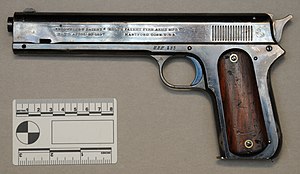| Colt M1900 | |
|---|---|
 Colt Model 1900 | |
| Type | Semi-automatic pistol |
| Place of origin | United States |
| Service history | |
| Used by | US Army, Navy, Commercial Customers |
| Wars | Moro Rebellion |
| Production history | |
| Designer | John Browning |
| Designed | 1897 |
| Produced | 1900–1902 |
| No. built | 4,274 |
| Variants | "Sight Safety" , First Army Contract, Navy Contract, Second Army Contract, "Sight Conversion" (retrofits and production) |
| Specifications | |
| Mass | 35 oz (990 g) |
| Length | 8.9 in (230 mm) |
| Barrel length | 6 in (150 mm)[1] |
| Cartridge | .38 ACP |
| Action | Short recoil operated Single-action trigger mechanism |
| Rate of fire | Semi-automatic |
| Muzzle velocity | 1,259 ft/s (384 m/s) |
| Effective firing range | 25 yards (23 m) |
| Feed system | 7 round box magazine |
The Colt Model 1900 is a short-recoil operated "self-loading", or semi-automatic .38 caliber handgun introduced by Colt's Manufacturing Company at the turn of the 20th century. The M1900 was the first firearm to be chambered in .38 ACP (not to be confused with the shorter-cased .380 ACP) and was the first handgun to utilize short-recoil operation.[2]
The M1900 was developed from John M. Browning's earlier prototypes in the late 1890s. The United States military tested the design against other semiautomatic pistols by European makers, and adopted some versions for trial use. The M1900 and variants were also offered commercially. Variants included the Model 1902 Sporting, Model 1902 Military, Model 1903 Pocket (only in .38 ACP models; the .32 ACP model was a different design), and the Model 1905, which introduced the .45 ACP cartridge.[3][4] Starting in 1909, new designs removed the front barrel link, which was replaced with a simple bushing. These designs evolved into the related M1911 pistol.[5]
- ^ "MEMIM Encyclopedia, Colt M1900". memim.com. Archived from the original on 2015-02-20. Retrieved 2015-02-20.
- ^ Chief of Ordnance. Annual Reports of the War Department, Fiscal Year Ended June 30, 1900, Report of the Chief of Ordnance. Government Printing Office, Washington, DC. pp. 177–188.
- ^ Potocki, John (1998). The Colt Model 1905 Automatic Pistol. Andrew Mowbray Publishing. ISBN 9780917218767.
- ^ Colt Model 1905 45 Automatic Pistol National Firearms Museum Archived September 14, 2015, at the Wayback Machine
- ^ S. P. Fjestad. Blue Book of Gun Values, 26th Ed. Blue Book Publications. ISBN 1-886768-55-2.